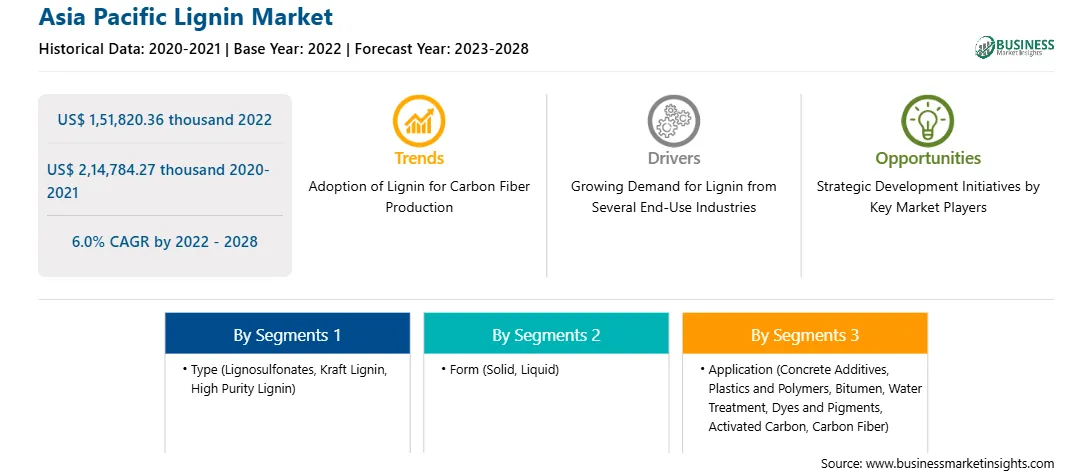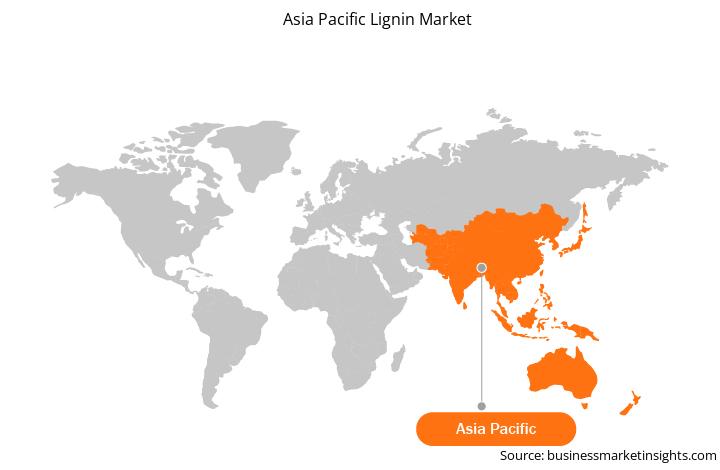Lignin is widely used in many industrial applications owing to its aromatic structure, relatively high energy content, and sustainability. Hence, the demand for lignin and its use is increasing across various end-use industries such as construction, paper & pulp, agriculture, animal feed, water treatment, and biofuel. Lignin is utilized in the building materials and construction industry as a set retardant, water-reducing admixture, and grinding agent in cement production. Lignin is used as a cement replacement material. It strengthens concrete by increasing its compressive strength; thus, its usage decreases carbon dioxide emissions during cement production and reduces the risk of depletion of natural material used for concrete production. A major advantage of using lignin is making the concrete process sustainable. Thus, the increasing use of lignin in concrete admixtures is driving the demand for lignin. Less than 2% of lignin is used as a dispersant, surfactant, and wood adhesive, while the rest is consumed as a direct combustion fuel to supply internal energy in biomass processes. In addition, lignin is the largest natural source of aromatics, which can potentially replace petroleum-based chemicals. Consumers are increasingly shifting toward eco-friendly products. Hence, the demand for bio-based, renewable, and circular solutions is increasing. For instance, Lineo, a high-purity kraft lignin material by Stora Enso Oyj, can replace fossil-based glue in plywood. In February 2023, Paged, a Polish plywood manufacturer, collaborated with Stora Enso Oyj to cater to customers’ demands for sustainable and bio-based plywood. This partnership allowed Paged to reduce carbon emissions through its products.
Furthermore, increasing demand for sustainable products has prompted several manufacturers to produce bio-based products such as bio-based plastics, lignin-based resins, lignin-based binders, lignin-based composites, bio-asphalt, biofuel, and bio-coatings, among others. In 2019, Latvijas Finieris developed RIGA ECOlogical in collaboration with Stora Enso Oyj. RIGA ECOlogical is eco-friendly lignin gluing technology aimed at replacing fossil-based phenol utilized in plywood production. In addition, lignin is used as an animal feed additive and offers multiple functionalities for improved productivity in the animal nutrition & health industry. Purified Alcell lignin can exhibit prebiotic effects in chickens, favoring the growth of good bacteria and improving the morphological structures of the intestines, as measured by increased villi height and goblet cell number. These findings suggest that purified lignin can offer health benefits in monogastric animals and serve as a potential natural feed additive. Hence, animal feed manufacturers increasingly use lignin as a natural feed additive. Therefore, the growing demand of lignin from several end-use industries drives the Asia Pacific lignin market growth.
Lignin is extracted from the wastewater of pulp and paper plants. Thus, the proliferation of -the paper and pulp industry contribute to a rise in lignin production. Lignin has a wide range of applications in industries such as automotive, construction, coatings, plastics and polymers, activated carbon, and pharmaceuticals. Moreover, lignosulfonate is extensively used to produce concrete, drywall, and concrete-based additives. In wastewater treatment processes, lignin-based hydrogels are used as pollutant adsorbents to eliminate metal cations and dyes.
According to a report published by the International Energy Agency in 2022, China was the world’s largest paper producer in 2020. In 2021, the country announced its plans to prioritize building a circular economy under its 14th Five-Year Plan (2021–2025), by attaining the capability of utilizing 66.1 million tons of wastepaper by 2025. Moreover, the governments of China, Thailand, the Philippines, and India have introduced programs and taken initiatives to support wastewater treatment projects and a circular economy via statutory or legislative provisions.
Strategic insights for the Asia Pacific Lignin provides data-driven analysis of the industry landscape, including current trends, key players, and regional nuances. These insights offer actionable recommendations, enabling readers to differentiate themselves from competitors by identifying untapped segments or developing unique value propositions. Leveraging data analytics, these insights help industry players anticipate the market shifts, whether investors, manufacturers, or other stakeholders. A future-oriented perspective is essential, helping stakeholders anticipate market shifts and position themselves for long-term success in this dynamic region. Ultimately, effective strategic insights empower readers to make informed decisions that drive profitability and achieve their business objectives within the market. The geographic scope of the Asia Pacific Lignin refers to the specific areas in which a business operates and competes. Understanding local distinctions, such as diverse consumer preferences (e.g., demand for specific plug types or battery backup durations), varying economic conditions, and regulatory environments, is crucial for tailoring strategies to specific markets. Businesses can expand their reach by identifying underserved areas or adapting their offerings to meet local demands. A clear market focus allows for more effective resource allocation, targeted marketing campaigns, and better positioning against local competitors, ultimately driving growth in those targeted areas.Asia Pacific Lignin Strategic Insights

Asia Pacific Lignin Report Scope
Report Attribute
Details
Market size in 2022
US$ 1,51,820.36 thousand
Market Size by 2028
US$ 2,14,784.27 thousand
Global CAGR (2022 - 2028)
6.0%
Historical Data
2020-2021
Forecast period
2023-2028
Segments Covered
By Type
By Form
By Application
Regions and Countries Covered
Asia-Pacific
Market leaders and key company profiles
Asia Pacific Lignin Regional Insights

Asia Pacific Lignin Market Segmentation
The Asia Pacific lignin market is segmented based on type, form, application, and country. Based on type, the Asia Pacific lignin market is segmented into lignosulfonates, kraft lignin, high purity lignin, and others. The lignosulfonates segment held the largest Asia Pacific lignin market share in 2022.
Based on form, the Asia Pacific lignin market is bifurcated into solid and liquid. The solid segment held a larger market share in 2022.
Based on application, the Asia Pacific lignin market is segmented into concrete additives, plastics and polymers, bitumen, water treatment, dyes and pigments, activated carbon, carbon fiber, and others. The concrete additives segment held the largest market share in 2022.
Based on country, the Asia Pacific lignin market is segmented into Australia, China, India, Japan, South Korea, and the Rest of Asia Pacific. China dominated the Asia Pacific lignin market share in 2022.
Nippon Paper Industries Co Ltd; Borregaard ASA; Burgo Group SpA; Domsjo Fabriker AB; Sappi Ltd; Stora Enso Oyj; Suzano SA; The Dallas Group of America Inc; and Tokyo Chemical Industry Co Ltd are the leading companies operating in the Asia Pacific lignin market.
The Asia Pacific Lignin Market is valued at US$ 1,51,820.36 thousand in 2022, it is projected to reach US$ 2,14,784.27 thousand by 2028.
As per our report Asia Pacific Lignin Market, the market size is valued at US$ 1,51,820.36 thousand in 2022, projecting it to reach US$ 2,14,784.27 thousand by 2028. This translates to a CAGR of approximately 6.0% during the forecast period.
The Asia Pacific Lignin Market report typically cover these key segments-
The historic period, base year, and forecast period can vary slightly depending on the specific market research report. However, for the Asia Pacific Lignin Market report:
The Asia Pacific Lignin Market is populated by several key players, each contributing to its growth and innovation. Some of the major players include:
The Asia Pacific Lignin Market report is valuable for diverse stakeholders, including:
Essentially, anyone involved in or considering involvement in the Asia Pacific Lignin Market value chain can benefit from the information contained in a comprehensive market report.